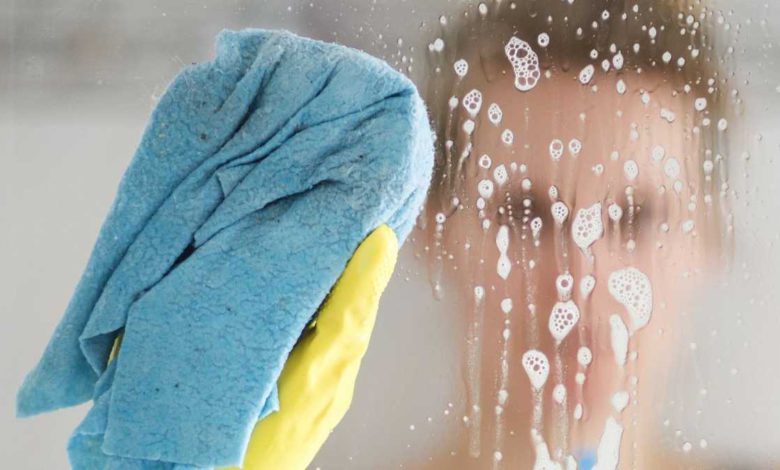
ever wonder if you clean your house as much as other people? A new study has some answers. According to a study of 2000 americans conducted by one poll on behalf of LG Electronics, the average respondent cleans their house seven times per month and deep cleans five times per month. The part of the house people most want clean is the floor, 62% would rather do a mountain of dishes as opposed to walking barefoot across a dirty floor. The LG electronics study found that these are the most enjoyed chores. 33% said laundry or folding clothes, 31% vacuuming, 31% doing dishes and 27% scrubbing down the cooking area. Laundry is a good one because it can be done while watching tv.
This is how to get rid of mold in your house for good
Mold has a bad reputation, which is mostly well deserved. While there are types of mold that are useful to humans, like penicillin, mold is an unwanted invader in our homes, capable of ruining belongings and causing allergic reactions that include watery eyes, runny nose, sneezing, skin rashes and even asthma attacks. In particular, the dreaded black mold has been known to cause respiratory problems, including pneumonia, in people with chronic illnesses. That's why it's so important to know how to get rid of mold safely.While it's best to keep places like your shower, tile grout, and dishwasher spick and span, small spots of mold here or there — no matter how unsightly — shouldn't cause dire health issues. But it is crucial to keep mold from spreading further. Give it an inch and it could take 10 square feet. That's the amount of mold you can try to eliminate yourself before you need to call in a professional. Likewise, according to the Environmental Protection Agency, you should hire a pro if the mold damage was caused by contaminated water like sewage. Otherwise, chances are you can do the job yourself — especially with these handy tips. But when in doubt, call a professional.PreventionOf course, a good defense does nothing but help the offense, and because mold needs moisture to grow, unless you cut down or even banish damp from your home, mold will keep coming back. Here are some of the best methods to dry out your house:Install vents or exhaust fans in spots that produce moisture, like the bathroom, kitchen and laundry room. Keep bathroom windows open when showering or bathing if possible.Don't use typically damp spaces, like the attic or basement, to store belongings.Run dehumidifiers in especially damp areas, including the basement. Overall humidity levels should stay below 50%. Repair any plumbing leaks.Reseal grout around your bathroom's tile annually.Clean air conditioning drip pans and ensure the drain lines are flowing. Keep your home's gutters and downspouts clean of debris, and make sure water is draining away from the foundation.Act fast in the case of a water leak or spill. If wet areas are dried within two days, mold will usually not have time to grow. PreparationWhile cleaning moldy surfaces, it's crucial to protect yourself against airborne spores. The EPA suggests wearing an N95 respirator mask, as well as gloves that reach the middle of the forearm. If you're using a particularly strong cleaning solution or bleach, the EPA recommends gloves that are made of "natural rubber, neoprene, nitrile, polyurethane or PVC." Never touch mold without gloves and always wear protective goggles without ventilation holes to keep the spores out of your eyes.While there are a variety of name-brand mold removers that work well, including Clorox Tilex Mold and Mildew Remover, the best mold fighter might be simple household bleach. Dilute it before using, mixing a cup of bleach with a gallon of water. Be sure to vent the area you're working in to avoid harmful fumes, and never combine bleach with ammonia.Other mold removers include: Undiluted white vinegar, which you can use in a spray bottle on kitchen and bath surfaces. It's a lot gentler than bleach, so it's best to let it sit for an hour, and be prepared to follow up with household cleaner to get rid of stubborn stains.Hydrogen peroxide is also a bleaching agent and will kill mold. Use a 3% solution in a spray bottle, and let it on the stain for at least 10 minutes before rinsing. How to eliminate mold on tile and groutAreas of your home with tile and grout can be the most difficult to keep mold-free because they are the very spaces that are the dampest. The bleach and water solution works especially well on these surfaces — just be sure to let it sit for at least 15 minutes before scrubbing. If the mold has spread to your shower curtain, toss it in the wash, following the care instructions if it's fabric. If it's plastic, wash it in warm water, on the delicate cycle, using both laundry soap and bleach. Or spray it down with a cleaner like Clorox Tilex Mold and Mildew Remover. When in doubt, replace it.How to eliminate mold on fabricFound a big box of old, moldy clothes in your basement that you've kept stashed away for years? Chances are, you'll have to toss them. However, if mold has only been developing on a fabric for a few days — say, on a damp swimsuit — you can usually save it. Take the fabric outside to brush away as much of the mold as you can.If the item is washable, follow the care instructions, rubbing in detergent directly on the stain. Wash in the hottest water as directed by the label. For stubborn stains, soak the fabric overnight in oxygen bleach and water.Take fabrics that aren't machine washable to a dry cleaner. If an item is made of leather, bring it outside and wipe it down with the solution made from distilled white vinegar. Follow it up with an application of leather soap and warm water. Apply a leather conditioner.How to eliminate mold on walls, ceilings and floorsUnfortunately, there are some materials, like carpeting and ceiling tiles, that you will almost always have to replace if they've grown mold. Generally, the more porous the substance, the better the chance you'll have to ditch it. To clean surfaces like drywall and plaster, mix dishwashing liquid (one part) with bleach (10 parts) and water (20 parts) and wipe it over affected areas, allowing it to air dry without rinsing.To kill mold on wood, begin by vacuuming the affected surface and the area around it with a vacuum equipped with a HEPA filter. Mold that hasn't deeply penetrated the wood can probably be taken care of with a solution of one teaspoon of dishwashing liquid and a spray bottle of water. Spritz the mold and carefully scrape it away with a soft-bristled brush, drying the surface with a soft towel when finished. If this doesn't work, try equal parts undiluted white vinegar and water. Should the mold return, use a teaspoon of borax combined with a cup of water. Scrape away the outer layer, allowing the borax to permeate the wood, inhibiting future mold growth.How to eliminate mold on household appliancesJust like you need to keep an eye on bathrooms, kitchens and laundry rooms for mold growth, so should you make sure that you're regularly cleaning the appliances in them to keep mold in check. Refrigerators can be wiped down with distilled white vinegar; for coffee makers, fill the reservoir with half water and half vinegar and let stand for a half-hour. Run the mixture through a brewing cycle, toss it, and then run plain water through several more cycles.Washing machines should be cleaned every month. Run them empty, with bleach, on the hot water cycle. Check both washers and refrigerators for mold on door seals.How to eliminate mold on the exterior of Your houseJust like it is indoors, mold is a serious problem on the outside of your home. Over time, mold can damage your siding and decks. Bleach works well to clean everything from siding to brick, stone, and concrete, but it will kill plants, so be sure to thoroughly cover them with plastic before beginning any project using it.To rid your home's exterior of mold, apply a 1-to-10 mixture of bleach and water on problem areas. Scrub stubborn stains with a stiff bristle brush, and be sure to leave the solution on for 20 minutes before rinsing.
Mold has a bad reputation, which is mostly well deserved. While there are types of mold that are useful to humans, like penicillin, mold is an unwanted invader in our homes, capable of ruining belongings and causing allergic reactions that include watery eyes, runny nose, sneezing, skin rashes and even asthma attacks. In particular, the dreaded black mold has been known to cause respiratory problems, including pneumonia, in people with chronic illnesses. That's why it's so important to know how to get rid of mold safely.
While it's best to keep places like your shower, tile grout, and dishwasher spick and span, small spots of mold here or there — no matter how unsightly — shouldn't cause dire health issues. But it is crucial to keep mold from spreading further. Give it an inch and it could take 10 square feet. That's the amount of mold you can try to eliminate yourself before you need to call in a professional. Likewise, according to the Environmental Protection Agency, you should hire a pro if the mold damage was caused by contaminated water like sewage. Otherwise, chances are you can do the job yourself — especially with these handy tips. But when in doubt, call a professional.
Prevention
Of course, a good defense does nothing but help the offense, and because mold needs moisture to grow, unless you cut down or even banish damp from your home, mold will keep coming back. Here are some of the best methods to dry out your house:
- Install vents or exhaust fans in spots that produce moisture, like the bathroom, kitchen and laundry room. Keep bathroom windows open when showering or bathing if possible.
- Don't use typically damp spaces, like the attic or basement, to store belongings.
- Run dehumidifiers in especially damp areas, including the basement. Overall humidity levels should stay below 50%.
- Repair any plumbing leaks.
- Reseal grout around your bathroom's tile annually.
- Clean air conditioning drip pans and ensure the drain lines are flowing.
- Keep your home's gutters and downspouts clean of debris, and make sure water is draining away from the foundation.
- Act fast in the case of a water leak or spill. If wet areas are dried within two days, mold will usually not have time to grow.
Preparation
While cleaning moldy surfaces, it's crucial to protect yourself against airborne spores. The EPA suggests wearing an N95 respirator mask, as well as gloves that reach the middle of the forearm. If you're using a particularly strong cleaning solution or bleach, the EPA recommends gloves that are made of "natural rubber, neoprene, nitrile, polyurethane or PVC." Never touch mold without gloves and always wear protective goggles without ventilation holes to keep the spores out of your eyes.
While there are a variety of name-brand mold removers that work well, including Clorox Tilex Mold and Mildew Remover, the best mold fighter might be simple household bleach. Dilute it before using, mixing a cup of bleach with a gallon of water. Be sure to vent the area you're working in to avoid harmful fumes, and never combine bleach with ammonia.
Other mold removers include:
- Undiluted white vinegar, which you can use in a spray bottle on kitchen and bath surfaces. It's a lot gentler than bleach, so it's best to let it sit for an hour, and be prepared to follow up with household cleaner to get rid of stubborn stains.
- Hydrogen peroxide is also a bleaching agent and will kill mold. Use a 3% solution in a spray bottle, and let it on the stain for at least 10 minutes before rinsing.
How to eliminate mold on tile and grout
Areas of your home with tile and grout can be the most difficult to keep mold-free because they are the very spaces that are the dampest. The bleach and water solution works especially well on these surfaces — just be sure to let it sit for at least 15 minutes before scrubbing. If the mold has spread to your shower curtain, toss it in the wash, following the care instructions if it's fabric. If it's plastic, wash it in warm water, on the delicate cycle, using both laundry soap and bleach. Or spray it down with a cleaner like Clorox Tilex Mold and Mildew Remover. When in doubt, replace it.
How to eliminate mold on fabric
Found a big box of old, moldy clothes in your basement that you've kept stashed away for years? Chances are, you'll have to toss them. However, if mold has only been developing on a fabric for a few days — say, on a damp swimsuit — you can usually save it.
- Take the fabric outside to brush away as much of the mold as you can.
- If the item is washable, follow the care instructions, rubbing in detergent directly on the stain. Wash in the hottest water as directed by the label. For stubborn stains, soak the fabric overnight in oxygen bleach and water.
- Take fabrics that aren't machine washable to a dry cleaner.
- If an item is made of leather, bring it outside and wipe it down with the solution made from distilled white vinegar. Follow it up with an application of leather soap and warm water. Apply a leather conditioner.
How to eliminate mold on walls, ceilings and floors
Unfortunately, there are some materials, like carpeting and ceiling tiles, that you will almost always have to replace if they've grown mold. Generally, the more porous the substance, the better the chance you'll have to ditch it. To clean surfaces like drywall and plaster, mix dishwashing liquid (one part) with bleach (10 parts) and water (20 parts) and wipe it over affected areas, allowing it to air dry without rinsing.
To kill mold on wood, begin by vacuuming the affected surface and the area around it with a vacuum equipped with a HEPA filter. Mold that hasn't deeply penetrated the wood can probably be taken care of with a solution of one teaspoon of dishwashing liquid and a spray bottle of water. Spritz the mold and carefully scrape it away with a soft-bristled brush, drying the surface with a soft towel when finished. If this doesn't work, try equal parts undiluted white vinegar and water. Should the mold return, use a teaspoon of borax combined with a cup of water. Scrape away the outer layer, allowing the borax to permeate the wood, inhibiting future mold growth.
How to eliminate mold on household appliances
Just like you need to keep an eye on bathrooms, kitchens and laundry rooms for mold growth, so should you make sure that you're regularly cleaning the appliances in them to keep mold in check. Refrigerators can be wiped down with distilled white vinegar; for coffee makers, fill the reservoir with half water and half vinegar and let stand for a half-hour. Run the mixture through a brewing cycle, toss it, and then run plain water through several more cycles.
Washing machines should be cleaned every month. Run them empty, with bleach, on the hot water cycle. Check both washers and refrigerators for mold on door seals.
How to eliminate mold on the exterior of Your house
Just like it is indoors, mold is a serious problem on the outside of your home. Over time, mold can damage your siding and decks. Bleach works well to clean everything from siding to brick, stone, and concrete, but it will kill plants, so be sure to thoroughly cover them with plastic before beginning any project using it.
To rid your home's exterior of mold, apply a 1-to-10 mixture of bleach and water on problem areas. Scrub stubborn stains with a stiff bristle brush, and be sure to leave the solution on for 20 minutes before rinsing.
Source link












